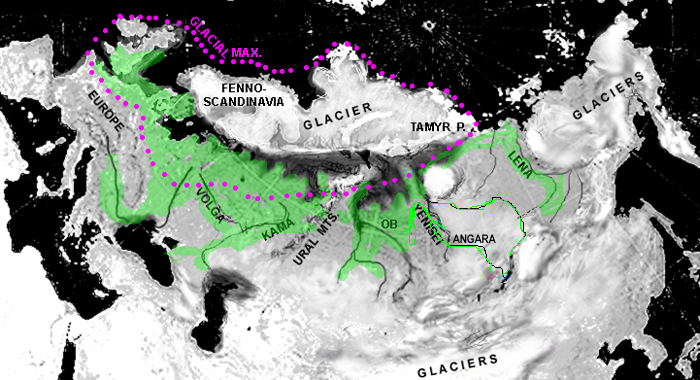
PREFACE 2018
When the Ice Age
retreated the glaciers that covered half of North America and Eurasia,
melted and flooded the lands underneath. "Uirala" refers to the flooded
lands, and the conversion of former reindeer peoples moving around on
foot, to boat peoples moving around in the flooded lands. These
projects bring forward accumulated information from archeology,
climatology, geography, etc. with a specific focus on the development
of the boat-oriented way of life that began south of the glaciers, and
then spread around the northern world
The world of science is inspired to dig up data
that contains information about the past, and had become good at it,
but interpreting the information is another thing, that requires a mind
that can see all the possibilities and find the most probable one.
The discoveries made by science have by now
overtaken the rate at which thinkers can bring together all the
accumulated information, and draw a picture of what happened in the
past. Scientists are specialized and narrowly focussed. They can
describe in detail differences in stone tools between two peoples, but
are not able or else interested in telescoping out and looking at the
large picture.
The following pages are the result of my
investigation of what science has found, but looking at it from space,
to get an overview of what happened in the human past, mainly in
Europe. I however am oriented to the lands and peoples who occupied the
lands released from under the Ice Age glaciers.
There is now far more information than was
available only a
century ago. But who is looking at this information and
interpreting it? I was surpised to discover just how much information
can be found about the prehistoric past, if you look for it in
scientific papers - now readily available on the internet. There are
maps and pictures too. But it takes a creative person to process the
accumulated information and discover the general story it tells about
the past. We restricted the reconstruction to the rise of boat peoples
to deal with the flooded lands, because it appeared it had been
overlooked. Traditionally books have simply referred to these people as
'hunter-gatherers' without grasping the fact that developing a boat
oriented way of life was as great an innovation in humankind as the
development of horseback riding. Both suddenly made peoples extremely
mobiles and premitted them to spread further than they could have, if
humans had remained pedestrians moving slowly on foot on solid ground.
Archeology has found evidence of the emergence of
the boat peoples in Europe in southern Scandinavia, when the reindeer
tundra of northern continental Europe was disappearing. Archeologists
called these new boat-oriented hunter gatherers the "Maglemose
Culture". They appear to have arisen out of the "Ahrensburg Culture"
reindeer hunters of what is now Germany/ They
rapidly expanded through the marshes, such as those of the south Baltic
coast. They may even have spread south via the Vistula marshes, and up
the lower Danube, going through all marshy lowlands that offered
passage for their dugout canoes. Boat peoples also developed in the
vicinity of Poland, perhaps from a combination of "Maglemose Culture"
and "Swiderian Culture". The latter were reindeer people. The result
was that the boat-oriented hunter-gatherers took an interest in animals
of the sea such as seals and whales (as suggested by their large
harpoons). Archeology has called this development the "Kunda Culture"
which too expanded east, but further north, reaching not just the Ural
Mountains area, but also the White Sea. The White Sea group had to
develop skin boats because the trees large enough for seagoing dugouts
were not available. (Only smaller trees for single-person dugouts).
Rock carvings show that theres White Sea boat
peoples with large skin boats hunted whales, using methods that were
found in the 17th century still practiced by Greenland Inuit. As you
will see, I wondered if languages of surviving arctic aboriginal
peoples contain words that can go back to the Baltic "Kunda Culture",
and I looked for words similar in form and meaning to words in Finnic
languages (mainly Finnish and Estonian) and found some remarkable
coincidences. It appears that a specialized whale-hunting people
developed who followed whales south along coasts.
What emerged was the appearance of a second major
migration of humans around the world. While the first one went by land,
this one went by water. One branch went through rivers and marshes. The
other branch went by seacoasts. Out of both arose long distance traders
in Europe, and the next investigation I pursued was to see if the
"Veneti" peoples mentioned in ancient texts in many parts of the
ancient world, were colonies of long distance traders north of the
Mediterranean, at a time when the Mediterranean had seagoing traders
speaking either Greek or Phoenician.
I did not expect at the beginning of this "UIRLALA"
pursuit around 2002, for the investigative journey to go further than
the rise of the boat peoples in the flooded lands south of the glaciers
around 12,000-10,000 years ago. But soon I was discovering something
not discovered before - the spread of Finnic-speaking aboriginal
whaling people around the arctic seas and down some coasts, and the
northern European boat peoples exploiting opportunities to carry goods
long distances for the emerging farming peoples who were tied to their
settlements, and welcomed the former nomadic hunter-gatherers to the
role of carrying wares up and down major European rivers. The name that
developed "Veneti", actually is identical to "VENEDE" which is genitive
plural of "VENE" meaning 'boat', hence meaning 'people of the boats'.

2018 (c) A. Pääbo.



